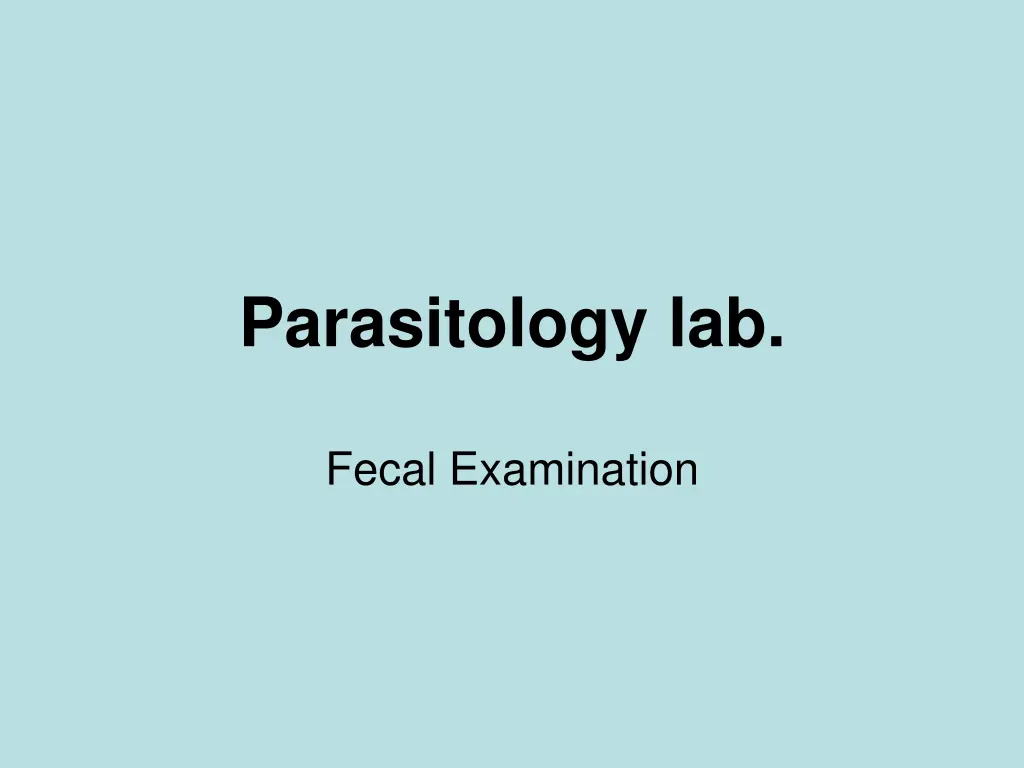
Guidelines for Fecal Examination in Parasitology Lab
Discover the proper method for collecting and preserving stool specimens for fecal examination in a parasitology lab. Learn about the importance of specimen collection, preservation techniques, and microscopic examination steps to detect parasites effectively.
Download Presentation

Please find below an Image/Link to download the presentation.
The content on the website is provided AS IS for your information and personal use only. It may not be sold, licensed, or shared on other websites without obtaining consent from the author. If you encounter any issues during the download, it is possible that the publisher has removed the file from their server.
You are allowed to download the files provided on this website for personal or commercial use, subject to the condition that they are used lawfully. All files are the property of their respective owners.
The content on the website is provided AS IS for your information and personal use only. It may not be sold, licensed, or shared on other websites without obtaining consent from the author.
E N D
Presentation Transcript
Parasitology lab. Fecal Examination
Specimen Collection Collect the stool in a dry, clean, leak-proof container. Make sure no urine, water, soil or other material gets in the container. Fresh stool should be examined, processed, or preserved immediately. An exception is specimens kept under refrigeration when preservatives are not available; these specimens are suitable for antigen testing only.
Preserve the specimen as soon as possible. If using a commercial collection kit, follow the kit s instructions. If kits are not available, the specimen should be divided and stored in two different preservatives, (10% formalin) using suitable containers. Add one volume of the stool specimen to three volumes of the preservative
Insure preservative. Formed stool needs to be well broken up. Insure that the specimen well. Reinforce with parafilm or other suitable material. Insert the container in a plastic bag. Certain drugs and compounds will render the stool specimens unsatisfactory for examination. The specimens should be collected before these substances are administered, or collection must be delayed until after the effects have passed. Such substances include: antacids, kaolin, mineral oil and other oily materials, non-absorbable antidiarrheal preparations, barium or bismuth (7-10 days needed for clearance of effects), antimicrobial agents (2-3 weeks), and gallbladder dyes (3 weeks). that the specimen is mixed well with the containers are sealed
Specimen collection may need to be repeated if the first examination is negative. If possible, three specimens passed at intervals of 2-3days should be examined.
Staining 1-Temporary : Saline, iodine, eosin 2- Permanent: Iron hematoxylin and Trichrome stain.
Fecal Examination the first step examination depend on the external appearance of the stool such as : the color , blood , constency , mucose , pus , proglottide , adult of parasite . 1 - Microscopic:
Microscopic (a) Saline wet amount examination: put a drop of normal saline on a glass slide and then put small amount of stool by wooden stick then mixed well and then covered with a cover slide. Then examined under a light microscope, it is important to examine specimen under 10X objective lens at first to observe large molecules, cells, ova and helminthes,then to the 40X objective to complete the test. It is preferable to keep the condenser down and the intensity of the light low for proper visualization of the ova and cysts.
(b)Iodine examination: Iodine preparation leads to better visualization of morphological details of ova and cysts as it stains the glycogen in them. put a drop of iodine on a glass slide and then put small amount of stool by wooden stick then mixed well and then covered with a cover slide. Then examined under a light microscope used the same step in saline examination .
Microscopic Examination Used the zigzag method when we examine the slide under microscope .
2- Concentration methods -Zinc sulphate flotation -Formalin ether sedimentation






















